He was ‘just running away’: Eyewitnesses dispute Boise police narrative of fatal shooting
Family members, reporters and police accountability advocates have pushed for months to know more about the police shooting in downtown Boise that killed a 22-year-old Nampa man over the summer. But despite the continued calls for more information, key details — why he was shot, whether he threatened anyone and how many rounds were fired — are still unknown.
In the early morning of June 24, a Boise police officer shot and killed Payton Wasson, whom the department said officers were investigating on suspicion of gang activity and drug dealing. Another man with Wasson at the time, Mario Garza, 27, of Kuna, was arrested and charged with three felonies.
Five months after the shooting, authorities are still blocking the public’s access to body-camera footage worn by police, leaving basic questions unanswered. Meanwhile, eyewitnesses dispute police’s description of what happened that early Saturday morning.
The Boise Police Department said Wasson was armed when officers approached him and disregarded commands to stop as he fled.
In a video interview with the Idaho Statesman from the Ada County Jail, Garza, who remains in custody on a $50,000 bond, said Wasson was “just running away.” When asked whether Wasson threatened the police in any way by pointing a gun at them or turning around, he replied, “100% no.”
“It’s all on video,” Garza added, referring to police body-cam footage. As a criminal defendant charged with two counts of possessing fentanyl with intent to deliver, plus a felony gang enhancement, Garza can review the footage as he prepares for trial, but the general public cannot.
This isn’t unusual. The Boise Police Department doesn’t release body-cam footage — or any investigative documents, including police reports — until after an investigation is completed. In the case of police shootings, that can be months or even years.
The only way to view officers’ body-cam footage before an investigation concludes is through the courts — as evidence presented in a criminal case or lawsuit. In the case of Wasson’s shooting, Garza’s related criminal case could give the public an opportunity to view body-cam footage earlier. Garza offered to provide the body-cam footage to the Statesman, but prosecutors in court filings said they reviewed the recorded call between Garza and the Statesman and moved to limit his ongoing access to the evidence.
“The investigation involves the shooting of Payton Wasson,” Ada County Deputy Prosecutor Ammon Judy told 4th Judicial District Judge James Cawthon at a hearing for Garza on Nov. 15. “It’s still an active investigation and not appropriate to disseminate information on an unrelated person and unrelated case.”
Up against the objection of Garza’s public defender, Judy failed in his bid to prevent Garza from receiving standard records through the legal process known as discovery. However, Cawthon allowed the state to redact anything related to Wasson, and ordered that such evidence not be given to anyone outside of Garza and his legal defense team. Garza’s trial is scheduled for February. If convicted, he could face up to life in prison.
Pierce Murphy directed the city’s police oversight office for 14 years before leaving for a similar position in Seattle. He has continually advocated for Boise police to release officers’ body-cam footage from use-of-force incidents earlier into an investigation.
“Boise can’t divorce itself from the rest of the country,” Murphy told the Statesman in a phone interview. “It’s now publicly expected that within a reasonable amount of time — sometimes it’s just days, oftentimes it’s weeks — after a fatal officer-involved shooting, or any sort of use of force that raises public questions, that that video footage is going to be released.”
Wasson’s death prompted as many as 100 people rallying outside of Boise City Hall to protest the shooting by police within a week of the downtown incident, the Statesman previously reported. Many of the attendees voiced concerns that the shooting was representative of systemic police misconduct issues and called for more transparency from the department.
Wasson’s mother, Marah Wasson, filed a tort claim against the city this week, Boise spokesperson Maria Weeg told the Statesman by text Thursday. A Chicago-based law firm representing the Wasson family confirmed the filing.
A spokesperson for law firm Romanucci & Blandin, who is representing the Wasson family, said it was challenging to file the tort claim because it asks for details of the incident, and the “family has yet to be allowed to view body- or dash-cam footage to understand the truth of what happened.”
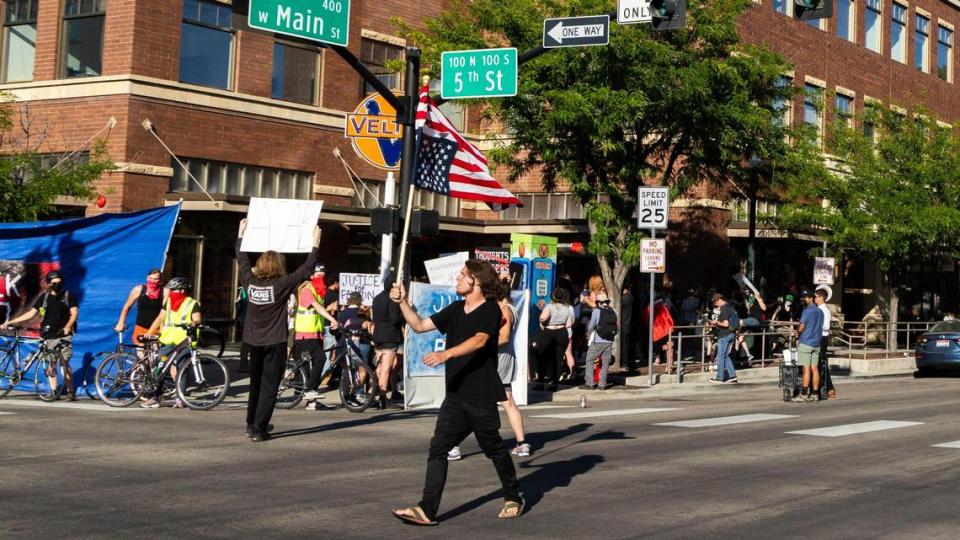
The dearth of information comes at a time when the city’s fatal police shootings have hit a decadeslong high, according to prior Statesman reporting. Boise also saw an unusually high number of police shootings in the 1990s when a lack of information and a “crisis in confidence” spurred the creation of the department’s oversight office in 1999, Murphy said.
When information is denied, Murphy said, it’s “human nature” to fill the void and question the secrecy. “And they think the worst, unfortunately,” he added.
Boise Police Chief Ron Winegar, in a statement to the Statesman, said his officers respond to calls every day involving people armed with weapons that reach peaceful resolutions.
“When there is a deadly threat to a member of the public or an officer, the decision to use deadly force is not taken lightly,” Winegar said. “I am thankful for the men and women of this agency who do the jobs we ask them to do with dignity, compassion, and a sense of duty — deeply held — to the community they serve. We value the work and the investigation by the Ada County Critical Incident Task Force and the outside prosecutor who will be reviewing this incident.”
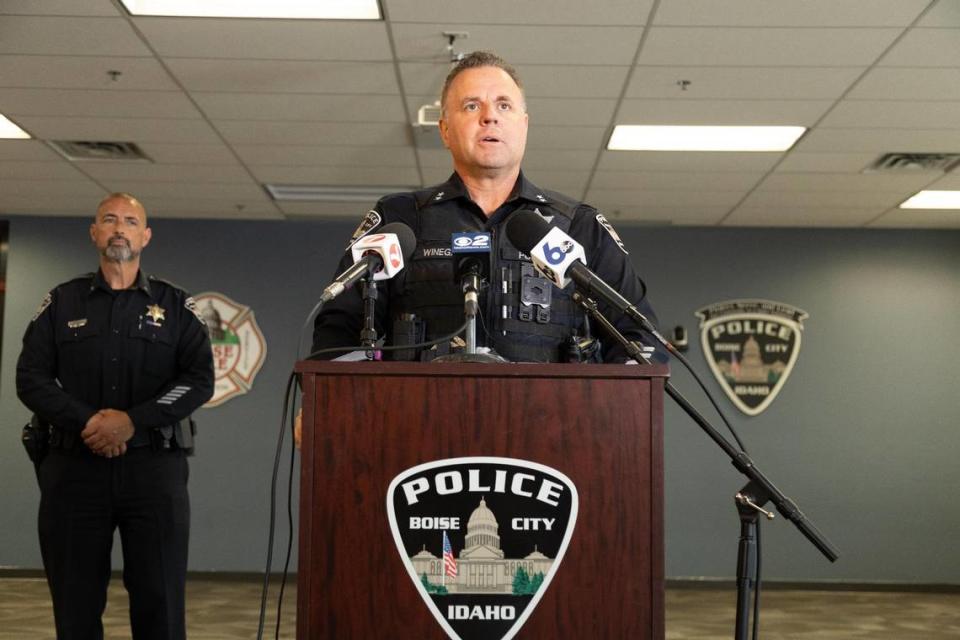
Police narrative differs from security footage
Several of the details from the incident, released by the Boise Police Department nearly a week afterward, do not align with security camera footage from a nearby retail store obtained by the Statesman. None of the group of three was inside Garza’s car when officers approached them, as the agency claimed, and the department’s statements about the location of the shooting conflict with the footage.
Just after 2 a.m. on Saturday, June 24, police were in downtown Boise near 5th and Main streets as part of an ongoing investigation, Boise police said in a news release at the time. Officers suspected two individuals, later identified as Wasson and Garza, were involved in gang activity or narcotics sales. Garza’s parole officer asked police to search Garza and his car.
Security footage, which included no audio, shows three people — two men and a woman — approach and linger next to a black Kia sedan, parked in reverse with its doors ajar, in a downtown strip mall parking lot just after 2:08 a.m. One of the men is wearing a tilted black baseball cap, white T-shirt and gray pants, and appears to smoke a cigarette. The other man is wearing a red baseball cap that matches his shoes, a black T-shirt with a gold chain around his neck and dark jeans.
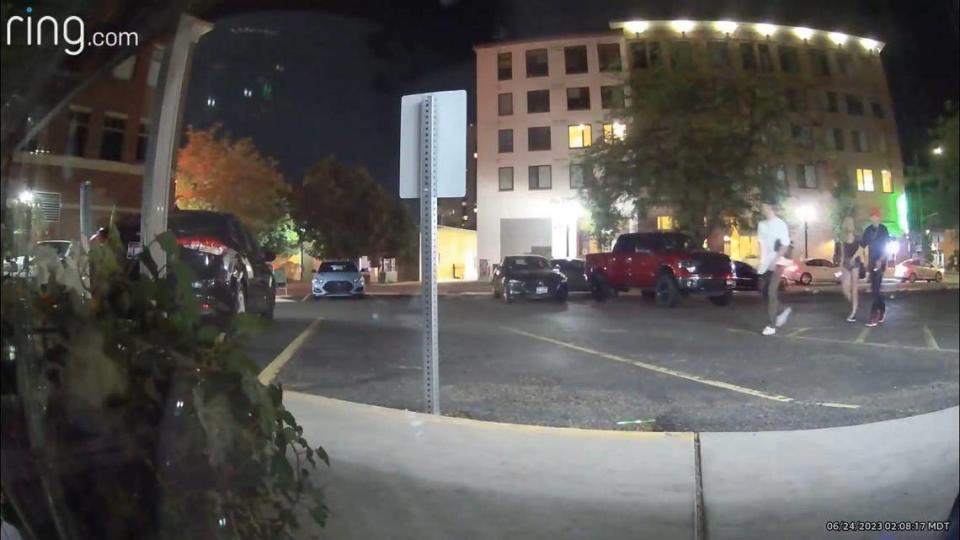
The woman has shoulder-length blonde hair and is wearing a sleeveless black shirt with spaghetti straps, gray shorts and a black purse. She later identified herself to the Statesman as Jordan Smith, 26, of Caldwell, and as Garza’s girlfriend. Smith confirmed stills of the security footage provided to her by the Statesman are of her, Garza and Wasson. A third person had been released at the scene, Boise police spokesperson Haley Williams told the Statesman in an email the day of the shooting.
Garza also confirmed that he, Wasson and Smith had approached his parked Kia in the downtown parking lot. Wasson’s mother also previously identified the three individuals in stills provided to her by the Statesman as her son, Garza and Smith.
In the footage, as Garza holds a cellphone to his ear, Wasson, in the white T-shirt, flicks his cigarette butt into the parking lot and slings a backpack over his right shoulder. He briefly ducks into the back seat on the passenger side of the car and shuts the door. Before they all leave the car, Smith double-checks that the passenger door is locked, and together they walk toward Idaho Street on 5th Street.
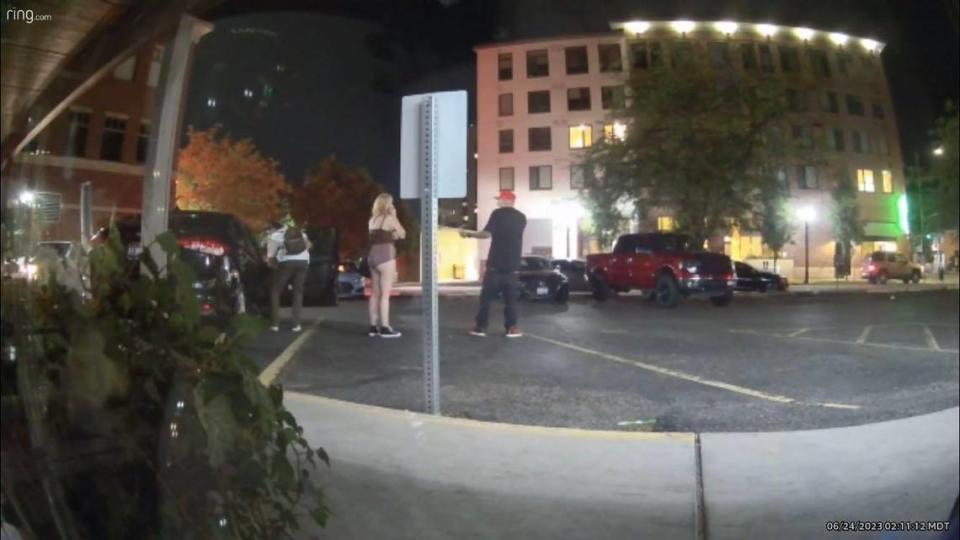
Altogether, they are in and out of the sedan in about three minutes and leave the parking lot toward the corner at Idaho Street, exiting the view of the security camera at 2:12 a.m. Moments later, a black unmarked SUV enters the frame headed northeast on 5th Street, turns on its headlights and speeds toward where Wasson, Garza and Smith walked. The SUV comes to a halt at the stoplight on Idaho Street with its red-and-blue lights flashing as officers exit.
Garza and Wasson had previous run-ins with the law. Garza was released from prison on parole in February after spending more than six years in prison for his involvement in a shooting. Wasson spent a brief amount of time in prison after violating his parole in 2019. He was also sentenced to 30 days in jail in 2021 after pleading guilty to disturbing the peace.
At about 2:12 a.m., officers “attempted to make contact with the occupants of the vehicle” when they returned to the car, according to a news release. When police approached, Wasson took off on foot toward Idaho Street, police said.
“He took off running and as he was running, they just shot him — they just like shot him four times,” Garza told the Statesman. “They could have tased him, they could have stopped him, you know?”
Police said officers saw Wasson with a gun in his hand, chased him and commanded him to stop. Wasson ignored their orders, police said, leading Officer Chance Feldner, who had 8 1/2 years with the Boise Police Department, to fire his department-issued semi-automatic pistol at Wasson. A gun was recovered next to Wasson, police said, though Williams declined to say what kind.
Feldner was the only officer to fire his weapon, according to police.
During the nighttime this past summer, Boise police had a group of officers downtown focused on investigating crimes that may be gang related, Williams said. Such was the case when the “patrol team” approached Wasson, Garza and Smith, she said.
The three were headed to a nearby food stand to grab late-night tacos, Smith told the Statesman. Suddenly, she said, police had their guns out as they arrived, each pointing assault-style rifles at them. Boise police officers who complete certain training are issued semi-automatic rifles in addition to their semi-automatic pistols, Williams said.
“I just stepped my foot off the sidewalk when the five undercover cop cars pulled up on us and they had us at gunpoint,” Smith said. “And Payton took off running, because he was scared.”
Witnesses say they didn’t see Wasson with a gun
As the Statesman previously reported, the police department’s policy manual outlines that officers are permitted to shoot their duty weapons to protect themselves or others from imminent danger. They may also do so to capture someone suspected of a felony whose escape would pose a significant threat to police or the public.
In interviews with the Statesman, Smith and Garza both said they never saw Wasson with a gun. Neither Wasson nor Garza legally could possess a gun because of past felony convictions.
“I didn’t see him have a gun. He didn’t point a gun at the police,” Smith said. “I didn’t see anything hit the ground, to be honest with you.”
Garza added in an interview with the Statesman that Wasson “didn’t pull a gun” on police.
Police haven’t disclosed how many times Feldner fired at Wasson, how many of those shots hit him and where he was hit. At least one bullet struck Wasson in the head, which the Ada County Coroner’s Office listed as his cause of death. Williams declined to answer those questions, citing the ongoing Critical Incident Task Force investigation automatically triggered by any police shooting. The Ada County Sheriff’s Office is overseeing the investigation.
“To maintain the integrity of the investigation, we cannot release those details as doing so could interfere with future prosecution,” Williams said by email.
Smith and Garza both said they heard police fire four shots at Wasson. Three of them hit Wasson, Smith said, then officers handcuffed her and Garza before arresting him on suspicion of possessing fentanyl pills.
Smith said she kept asking police about Wasson while they were handcuffed.
“They tried telling us that the bullets like (grazed) the side of his head and that he was talking, and he was breathing, and he was fine, and that there was hardly any blood,” Smith said. “Which, I mean, obviously, clearly was a lie because they shot him three times in the head and he’s dead.”
Wasson, taken to a local hospital with life-threatening injuries, died there the next day, police said.
“Saturday’s shooting in downtown Boise was a tragedy for the Wasson family, it was a tragedy for those who were witnesses and for our community,” Winegar said in a statement later that week. “If this incident involved a member of my family, I too would want more information about what happened. We are investigating what happened to ensure integrity and accountability.”
Feldner remains employed with Boise police, Williams said. But Boise police does not provide updates or information about an officer’s return to active duty after they’re involved in a shooting and are placed on paid administrative leave, she said.
Why public waits months to learn what happened
The Ada County Sheriff’s Office finished its report on the Wasson shooting at the end of August, department spokesperson Patrick Orr said. The Twin Falls County Prosecutor’s Office is handling the legal review into whether Feldner was justified in the shooting. Prosecutor Grant Loebs told the Statesman he’s still awaiting the autopsy report for review and then will issue his recommendation. That usually takes about a week, Loebs said.
Investigators and the outside prosecutor typically take several months to finalize an investigation. In cases of a nonfatal shooting and the person shot by police was charged with a crime, law enforcement won’t release any investigative reports or footage until the defendant’s case is finalized — which can take more than a year.
Out of the six shootings this year that involved a Boise police officer, including four that were fatal, just one shooting investigation has been released, for 23-year-old Gavin Donithorne. A Boise police officer and a now-retired Ada County Sheriff’s sergeant were cleared of any wrongdoing, and Donithorne was sentenced to up to 10 years in prison on Nov. 7.
The other five shootings remain under investigation, including a fatal shooting from January — more than 10 months ago.
The Boise Police Department, which is responsible for releasing information from their officers’ shootings, previously said it has “tried to be consistent” about releasing updates on CITF investigations, but on occasion, has failed to issue a news release. Other law enforcement agencies, including at least two Canyon County departments that previously confirmed the policy to the Statesman, don’t notify the public when an investigation is finished.
Williams previously told the Statesman that the information is “always available through a public records request.” The CITF reports can be expensive — sometimes more than $1,000 — because of the cost of redacting and reviewing body-cam footage. The police department will release a portion of the footage, but it’s typically edited with captions added and doesn’t show the entirety of the shooting incident.
Weeg, also Boise Mayor Lauren McLean’s spokesperson, said the city is working to post completed reports to the police department and the city’s Office of Police Accountability websites at no cost. This comes after repeated requests for such a system and pushback from the Statesman about the high price tag of the reports.
Weeg told the Statesman by email there isn’t an exact time frame for when the reports will become available, but the city plans to post body-cam footage and other investigative documents along with the reports when the investigation concludes. The city hopes to include information about the current status of active investigations as well, she added.
The Ada County Sheriff’s Office began posting CITF reports in incidents that involved its deputies in 2018 and started publishing them to a standing webpage last year, Orr said.
Murphy, Boise’s former oversight director, told the Statesman that if the community expects officers’ body-cam footage to be released, then the police need to do so. Video footage can be misleading and doesn’t tell the whole story, he added, but residents should be able to watch the footage, draw their own conclusions and then wait for the criminal justice system to catch up.
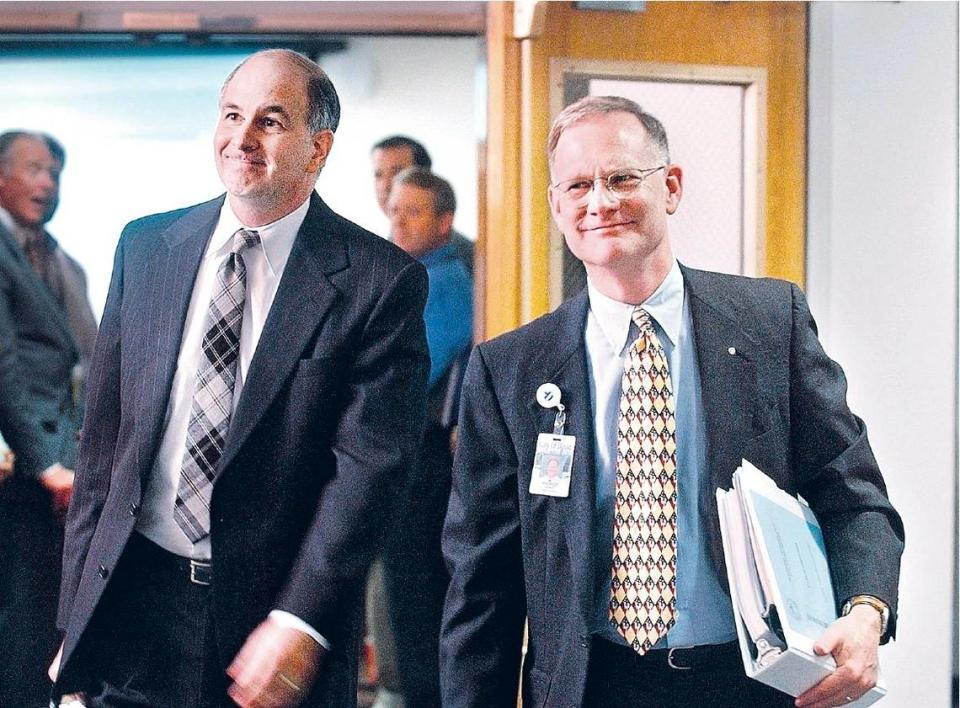
Prosecutors object to timely release of video
The Wasson shooting is not the first time officials’ reluctance to release body-cam footage has received scrutiny. In 2021, after officers shot and injured Somali refugee Mohamud Mkoma, sparking protests and calls for transparency, McLean pushed the Ada County Prosecutor’s Office to release the footage. The footage still hasn’t been released, though the Statesman was able to watch a portion of it during an early November court proceeding.
Prosecutor Jan Bennetts responded by saying releasing footage early impedes the judicial process. In an email to the Statesman, the office’s spokesperson, Emily Lowe, reaffirmed the office’s position, while stating that police agencies have the final say.
“Premature release of any evidence in criminal investigations violates the due process rights of those who may be charged and prevents a fair trial,” Lowe said. “With this consideration in mind, law enforcement operates independently of this office, but also have a similar interest in preserving due process.” Lowe added in a follow-up email that the early release of evidence also violates ethical obligations that attorneys are expected to follow.
Weeg said the timely release of body-cam footage is a “high priority” for the city, but officials must also adhere to state law and maintain a “strong working relationship” with the police department.
“Boise residents value our police officers and the relationships we have with them. We are fortunate to live in a safe community — keeping it that way takes a commitment to transparency, adherence to state law and strong working relationships,” Weeg said in an email to the Statesman. “The release of (body-cam footage) requires a balance of all of those factors.”
Idaho law doesn’t mandate body-cam footage has to be released within a specific time frame, unlike some other states, Weeg said. Additionally, body-cam footage along with other investigatory records are exempt from release under Idaho’s Public Records Act when they would interfere with an investigation or an individual’s right to a fair trial.
Murphy said the concerns around the early release of footage don’t outweigh the very “real possibility” of the community mistrusting the police. The public isn’t as willing as it used to be to immediately believe shootings are justified, Murphy said. Instead, they want more information before deciding.
Murphy wants officers to be effective, fair and be able to “do their job according to the law,” he said. “But they can’t do their job if the public doesn’t trust them.”

